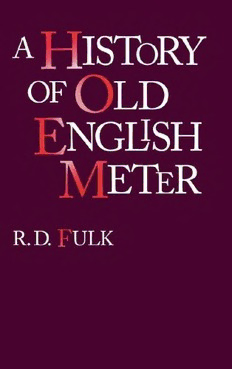
A History of Old English Meter PDF
Preview A History of Old English Meter
A History of Old English Meter University of Pennsylvania Press MIDDLE AGES SERIES Edited by Edward Peters Henry Charles Lea Professor of Medieval History University of Pennsylvania A History of Old English Meter R. D. FULK University of Pennsylvania Press Philadelphia This publication has been supported by a grant from the National Endowment for the Humanities, an independent federal agency. Copyright © 1992 by the University of Pennsylvania Press All rights reserved Library of Congress Cataloging-in-Publication Data Fulk, R. D. (Robert Dennis) A history of Old English meter / R. D. Fulk. p. cm. — (Middle Ages series) Includes bibliographical references and index. ISBN 0-8122-3157-0 1. English language—Old English, ca. 450-1100—Versification. I. Title. II. Series. PE257.F85 1992 829'.1—dc20 92-30918 CIP For Al and Linda David This page intentionally left blank PREFACE The recent early death of Ashley Crandell Amos is a source of profound regret for Anglo-Saxonists of all interests, but particularly metrists and philologists. Her work on the dating of Old English literature is more ambitious and of wider scope than any similar project conceived by Eduard Sievers and his contemporaries, and its effect on the study of Old English verse has been profound. Although the present study lends sup- port to few of her conclusions about metrical history, it should be apparent that the sort of research presented here would not be possible without the background of the questions about Old English philology that she posed, and the framework for discussion that she constructed. The influence of her work is pervasive in the following pages, and it is to the work of Ashley Amos and Eduard Sievers that this study is most indebted. It is a pleasure to acknowledge two particular debts, to Thomas Cable and Geoffrey R. Russom, who first gave me detailed and perceptive ad- vice about the chapters of this study devoted to resolution and tertiary stress, and subsequently read the entire manuscript carefully and dis- cerningly for the University of Pennsylvania Press. This book has bene- fited from their suggestions in countless ways. I am indebted to them in a more general sense, as well, since the influence of their published research on Old English meter should be clear throughout. Some of the conclusions of Chapter 1 were published under the title "West Germanic Parasiting, Sievers' Law, and the Dating of Old English Verse," SP 86 (1989), 117-38; and a draft of Chapter 2 appeared as "Contraction as a Criterion for Dating Old English Verse," JEGP 89 (1990), 1-16.1 am grateful to the editors of SP and JEGP for permission to incorporate this material here. While this book was undergoing final revisions I received from Rand Hutcheson portions of his 1991 doctoral dissertation (see below, p. 67, n. 2), in which he reconsiders some of the issues raised in the former of the articles mentioned above, and in a 1989 MLA paper based on the chapters below dealing with resolution. The portions of Hutcheson's dissertation that I have seen contain much interesting and useful material, and I am grateful that I have had the opportunity to read them and discuss them with the author. This book has benefited from his criticisms. It is to be hoped that his dissertation will be published, so that his ideas may be discussed in greater depth. Much of the initial statistical research for this book was carried out at the University of Copenhagen during the period 1987-88. For their viii PREFACE hospitality I wish to thank friends and colleagues who are or were in Denmark, and particularly Graham and Ann Caie, H. James and Susan Jensen, and Steen Schousboe and Jette Hollander. Many scholars lent their kind advice in matters of detail, and furnished assistance of various sorts. In particular I wish to thank Alfred Bammesberger, Mary Blockley, Joseph P. Crowley, Alfred David, Daniel Donoghue, B. Elan Dresher, Kari Gade, J. R. Hall, Constance Hieatt, Calvin Kendall, Eugene Kintgen, Timothy Long, M. MacMahon, Peter J. Lucas, Donka Minkova, R. I. Page, Herbert Penzl, John C. Pope, Irmen- gard Rauch, Samuel Rosenberg, Thomas Shippey, Robert P. Stockwell, Mark Taylor, Jun Terasawa, and Joseph F. Tuso. Indiana University provided a grant for the purchase of the computer software required for the production of this volume, and another small grant defrayed part of the production costs. For their part in securing these funds I owe thanks to Dean Morton Lowengrub, Associate Dean Albert Wertheim, and Professors Patrick Brantlinger, Mary Burgan, and Roger Farr. Jerome Singerman at the University of Pennsylvania Press has provided invaluable help at every turn, and has shown more than a little courage in taking on such a large and unconventional manuscript. Edward Peters kindly included this volume in the Middle Ages Series. I am deeply in- debted also to Mindy Brown, Catherine Gjerdingen, and Carl Gross for the extraordinary care they took with the manuscript, and to Kathleen Moore and others at the Press. Finally I can only offer thanks to Brian Powell—as if thanks were enough. R. D. F. June 1992
